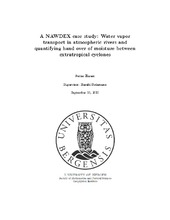A NAWDEX case study: Water vapor transport in atmospheric rivers and quantifying hand over of moisture between extratropical cyclones
Master thesis
Permanent lenke
https://hdl.handle.net/1956/24449Utgivelsesdato
2020-10-31Metadata
Vis full innførselSamlinger
- Master theses [123]
Sammendrag
Meridional water vapor transport occurs predominantly within the warm sector of extratropical cyclones. The warm sector is seperated by the cyclone's warm front ahead, and the cold front behind. In this region the warm conveyor belt or the atmospheric river reside. Little is known about the joint water vapor transport of multiple extratropical cyclones and their sequential interaction. This thesis attempts to identify if, and quantify how much water vapor left behind in the atmosphere by an extratropical cyclone, is incorporated into the air flow of the successive cyclone. The water vapor associated with the cyclone's center and its frontal structure have been separated to investigate which parts of the cyclone contributes the most to the process of "handover" of water vapor. The atmospheric model, COSMO-tag that is equipped with a water vapor tagging implementation, is used to identify the water vapor sources associated with the respective cyclones. Comparisons of observations gathered by dropsondes during the NAWDEX field campaign and model results show an over all good agreement in resolving the water vapor signature of atmospheric rivers. Model results indicate that substantial amounts of water vapor are handed over from one cyclone to another. Contributions of 10% to the total amount of moisture close to the cyclone's center is attributed to the handover process. Another remarkable result is the handover of moisture from atmospheric rivers into the cyclone's air flow and their association with precipitation contributions near the cyclone's center.
